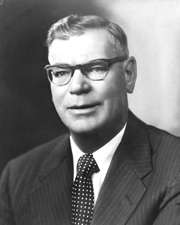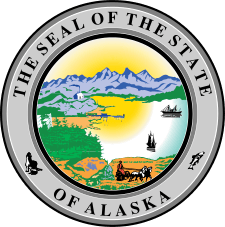Bob Bartlett
| Bob Bartlett | |
|---|---|
 | |
| United States Senator from Alaska | |
|
In office January 3, 1959 – December 11, 1968 | |
| Preceded by | Seat established |
| Succeeded by | Ted Stevens |
| Member of the U.S. House of Representatives from Alaska Territory's at-large district | |
|
In office January 3, 1945 – January 3, 1959 Delegate | |
| Preceded by | Anthony Dimond |
| Succeeded by | Ralph Rivers (Representative) |
| Personal details | |
| Born |
April 20, 1904 Seattle, Washington, U.S. |
| Died |
December 11, 1968 (aged 64) Cleveland, Ohio, U.S. |
| Political party | Democratic |
| Spouse(s) | Vide Gaustad |
| Alma mater |
University of Washington, Seattle University of Alaska, Fairbanks |
Edward Lewis "Bob" Bartlett (April 20, 1904 – December 11, 1968) was an American politician and a member of the Democratic Party.
Bartlett was born on April 20, 1904 in Seattle, Washington to Edward C. and Ida Florence (nee Doverspike) Bartlett. After attending the University of Washington from 1922 to 1924, Bartlett graduated from the University of Alaska in 1925, then began his career in politics. A reporter for the Fairbanks Daily News until 1933, he accepted the position of secretary to Delegate Anthony Dimond of Alaska. Three years later he became the chairman of the Unemployment Compensation Commission of Alaska.
On January 30, 1939, President Franklin D. Roosevelt appointed him secretary of the Alaska Territory. Beginning in 1945, Bartlett served as the delegate from Alaska to the 79th and the six succeeding Congresses. Continuing his civic service, he was president of the Alaska Tuberculosis Association and served as a member of the Alaska War Council. He labored constantly for statehood; upon Alaska's admission to the Union in 1959 he became the first senator from Alaska and served until 1968.
Bartlett possessed the reputation of a quiet man of achievement. The Library of Congress estimates that he had more bills passed into law than any other member in congressional history. Before statehood, he was writing legislation (sponsored by other congressional representatives), such as the Alaska Mental Health Enabling Act of 1956. Some of his bills included the Radiation Safety Bill and the Bartlett Act, requiring all federally funded buildings to be accessible to the handicapped.
Bartlett died following heart surgery on December 11, 1968 at Cleveland Clinic Hospital in Cleveland, Ohio. He was buried in Northern Lights Memorial Park in Fairbanks, Alaska. Ted Stevens was appointed to replace him on December 24, 1968.
In 1971, the state of Alaska commissioned Felix de Weldon to create a bronze statue of Bartlett which resides in the National Statuary Hall Collection at the United States Capitol.
A substantial number of buildings, place names and more have been named after Bartlett in Alaska over the years. The most notable of these include Bartlett Regional Hospital (originally St. Ann's Hospital, and known for a time as Bartlett Memorial Hospital), the hospital serving Juneau,[1] as well as Bartlett High School in Anchorage and Bartlett Hall at the University of Alaska Fairbanks.
References
- ↑ "Accumulated Fragments - Bartlett: the stories behind the name". Juneau Empire. 14 November 2010. Retrieved 8 July 2015.
External links
- United States Congress. "Bob Bartlett (id: B000201)". Biographical Directory of the United States Congress.
- The "Architect of Alaskan Statehood"
- Bartlett Regional Hospital home page
| United States House of Representatives | ||
|---|---|---|
| Preceded by Anthony Dimond |
Delegate to the U.S. House of Representatives from Alaska Territory's at-large congressional district 1945–1959 |
Succeeded by Ralph Rivers as Representative |
| Party political offices | ||
| New seat | Democratic nominee for U.S. Senator from Alaska (Class 2) 1958, 1960, 1966 |
Succeeded by Wendell Kay |
| United States Senate | ||
| New seat | U.S. Senator (Class 2) from Alaska 1959–1968 Served alongside: Ernest Gruening |
Succeeded by Ted Stevens |



